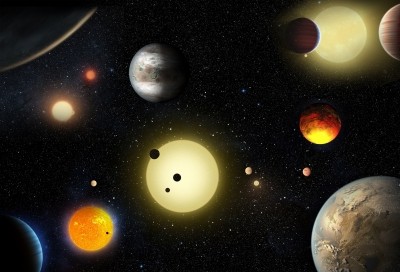IANS Photo

New York, December 29 (IANS) A low carbon abundance in planetary atmospheres could be a signature of habitability, according to scientists.
The scientists at MIT, the University of Birmingham, proposed that if a terrestrial planet has substantially less carbon dioxide in its atmosphere compared to other planets in the same system, it could be a sign of liquid water -- and possibly life -- on that planet’s surface.
“The Holy Grail in exoplanet science is to look for habitable worlds, and the presence of life, but all the features that have been talked about so far have been beyond the reach of the newest observatories,” said Julien de Wit, assistant professor of planetary sciences at MIT.
“Now we have a way to find out if there’s liquid water on another planet. And it’s something we can get to in the next few years," de Wit added.
In the paper, published in the journal Nature Astronomy, the team described how the idea came to them "by looking at what’s going on with the terrestrial planets in our own system."
Venus, Earth, and Mars share similarities, in that all three are rocky and inhabit a relatively temperate region with respect to the sun.
Earth is the only planet among the trio that currently hosts liquid water. And the team noted another obvious distinction --Earth has significantly less carbon dioxide in its atmosphere.
“We assume that these planets were created in a similar fashion, and if we see one planet with much less carbon now, it must have gone somewhere,” said Amaury Triaud of the University of Birmingham in the UK.
“The only process that could remove that much carbon from an atmosphere is a strong water cycle involving oceans of liquid water.”
The team reasoned that if a similar depletion of carbon dioxide, like on Earth were detected in a far-off planet, relative to its neighbours, this would be a reliable signal of liquid oceans and life on its surface.
But habitable conditions doesn’t necessarily mean that a planet is inhabited. To see whether life might actually exist, the team proposes that astronomers look for another feature in a planet’s atmosphere: ozone.
The researchers noted that if a planet’s atmosphere shows signs of both ozone and depleted carbon dioxide, it likely is a habitable, and inhabited world.
“If we see ozone, chances are pretty high that it’s connected to carbon dioxide being consumed by life,” Triaud said. “And if it’s life, it’s glorious life. It would not be just a few bacteria. It would be a planetary-scale biomass that’s able to process a huge amount of carbon, and interact with it.”
The team said that James Webb Space Telescope (JWST) can easily detect exoplanets with relatively depleted carbon dioxide and possibly ozone, in nearby, multiplanet systems such as TRAPPIST-1 -- a seven-planet system that orbits a bright star, just 40 light years from Earth.



.jpeg)


